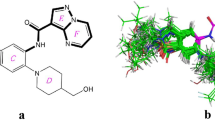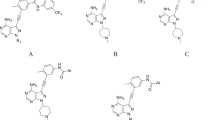Abstract
Cancer is a second major disease after metabolic disorders where the number of cases of death is increasing gradually. Mammalian target of rapamycin (mTOR) is one of the most important targets for treatment of cancer, specifically for breast and lung cancer. In the present research work, Comparative Molecular Field Analysis (CoMFA) and Comparative Molecular Similarity Indices Analysis (CoMSIA) studies were performed on 50 compounds reported as mTOR inhibitors. Three different alignment methods were used, and among them, distill method was found to be the best method. In CoMFA, leave-one-out cross-validated coefficients \((q^{2})\), conventional coefficient \((r^{2})\), and predicted correlation coefficient \((r^{2}_{\mathrm{pred}})\) values were found to be 0.664, 0.992, and 0.652, respectively. CoMSIA study was performed in 25 different combinations of features, such as steric, electrostatic, hydrogen bond donor, hydrogen bond acceptor, and hydrophobic. From this, a combination of steric, electrostatic, hydrophobic (SEH), and a combination of steric, electrostatic, hydrophobic, donor, and acceptor (SEHDA) were found as best combinations. In CoMSIA (SEHDA), \(q^{2}\), \(r^{2}\) and \(r^{2}_{\mathrm{pred}}\) were found to be 0.646, 0.977, and 0.682, respectively, while in the case of CoMSIA (SEH), the values were 0.739, 0.976, and 0.779, respectively. Contour maps were generated and validated by molecular dynamics simulation-assisted molecular docking study. Highest active compound 19, moderate active compound 15, and lowest active compound 42 were docked on mTOR protein to validate the results of our molecular docking study. The result of the molecular docking study of highest active compound 19 is in line with the outcomes generated by contour maps. Based on the features obtained through this study, six novel mTOR inhibitors were designed and docked. This study could be useful for designing novel molecules with increased anticancer activity.









Similar content being viewed by others
References
Jemal A, Bray F, Melissa M, Ferlay J, Ward E, Forman D (2011) Global cancer statistics. CA Cancer J Clin 61:69–90. doi:10.3322/caac.20107
World Health Organization (WHO), Geneva. http://www.who.int/mediacentre/factsheets/fs297/en/. Accessed 26 March 2017
Fumarola C, Bonelli MA, Petronini PG, Alfieri RR (2014) Targeting PI3K/AKT/mTOR pathway in non-small cell lung cancer. Biochem Pharmacol 90:197–207. doi:10.1016/j.bcp.2014.05.011
Marinov M, Fischer B, Arcaro A (2007) Targeting mTOR signaling in lung cancer. Crit Rev Oncol Hemat 63:172–182. doi:10.1016/j.critrevonc.2007.04.002
Kim KM, Heo DR, Lee J, Park JS, Baek MG, Yi JM, Kim H, Bang OS (2015) 5,3\(^{\prime }\)-Dihydroxy-6,7,4\(^{\prime }\)-trimethoxyflavanone exerts its anticancer and antiangiogenesis effects through regulation of the Akt/mTOR signalling pathway in human lung cancer cells. Chem Biol Interact 225:32–39. doi:10.1016/j.cbi.2014.10.033
Efeyan A, Sabatini DM (2010) mTOR and cancer: many loops in one pathway. Curr Opin Cell Biol 22:169–176. doi:10.1016/j.ceb.2009.10.007
Yang H, Rudge DG, Koos JD, Vaidialingam B, Yang HJ, Pavletich NP (2013) mTOR kinase structure, mechanism and regulation. Nature 497:217–223. doi:10.1038/nature12122
Chiarini F, Evangelisti C, McCubrey J, Martelli AM (2015) Current treatment strategies for inhibiting mTOR in cancer. Trends Pharmacol Sci 36:124–135. doi:10.1016/j.tips.2014.11.004
Lipinski CA, Lambardo F, Dominy BW, Feeney PJ (1997) Experimental and computational approaches to estimate solubility and permeability in drug discovery and development settings. Adv Drug Deliv Rev 23:3–25. doi:10.1016/S0169-409X(96)00423-1
Estrada AA, Shore DG, Blackwood E, Chen Y, Deshmukh G, Ding X, Dipasquale AG, Epler JA, Friedman LS, Koehler MFT, Liu L, Malek S, Nonomiya J, Ortwine DF, Pei Z, Sideris S, St-jean F, Trinh L, Truong T, Lyssikatos JP (2013) Pyrimidoaminotropanes as potent, selective, and efficacious small molecule kinase inhibitors of the mammalian target of rapamycin (mTOR). J Med Chem 56:3090–3101. doi:10.1021/jm400194n
Pei Z, Blackwood E, Liu L, Malek S, Belvin M, Koehler MFT, Ortwine DF, Chen H, Cohen F, Kenny JR, Bergeron P, Lau K, Ly C, Zhao X, Estrada AA, Truong T, Epler JA, Nonomiya J, Trinh L, Sideris S, Lesnick J, Bao L, Vijapurkar U, Mukadam S, Tay S, Deshmukh G, Chen Y, Ding X, Friedman LS, Lyssikatos JP (2013) Discovery and biological profiling of potent and selective mTOR inhibitor GDC-0349. J Med Chem 4:103–107. doi:10.1021/ml3003132
Koehler MFT, Bergeron P, Blackwood E, Bowman KK, Chen Y, Deshmukh G, Ding X, Epler J, Lau K, Lee L, Liu L, Ly C, Malek S, Nonomiya J, Oeh J, Ortwine DF, Sampath D, Sideris S, Trinh L, Truong T, Wu J, Pei Z, Lyssikatos JP (2012) Potent, selective, and orally bioavailable inhibitors of the mammalian target of rapamycin kinase domain exhibiting single agent antiproliferative activity. J Med Chem 55:10958–10971. doi:10.1021/jm301389h
Borisa A, Bhatt HG (2015) 3D-QSAR (CoMFA, CoMFA-RG, CoMSIA) and molecular docking study of thienopyrimidine and thienopyridine derivatives to explore structural requirements for aurora-B kinase inhibition. Euro J Pharm Sci 79:1–12. doi:10.1016/j.ejps.2015.08.017
Sridhar J, Foroozesh M, Stevens CLK (2011) QSAR models of cytochrome P450 enzyme 1A2 inhibitors using CoMFA, CoMSIA and HQSAR. SAR QSAR Environ Res 22:681–697. doi:10.1080/1062936X.2011.623320
Wang JH, Hou QQ, Tang K, Cheng XL, Dong LH, Liu YJ, Liu CB (2011) Receptor-based QSAR study for a series of 3,3-disubstituted-5-aryl oxindoles and 6-aryl benzimidazol-2-ones derivatives as progesterone receptor inhibitors. SAR QSAR Environ Res 22:775–799. doi:10.1080/1062936X.2011.623324
Saqib U, Kumar B, Siddiqi MI (2011) Structural investigations of anthranilimide derivatives by CoMFA and CoMSIA 3D-QSAR studies reveal novel insight into their structures toward glycogen phosphorylase inhibition. SAR QSAR Environ Res 22:411–449. doi:10.1080/1062936X.2011.569898
Chaube UJ, Bhatt HG (2016) 3D-QSAR, molecular dynamics simulations and molecular docking studies of benzoxazepine moiety as mTOR inhibitor for the treatment of lung cancer. Bioorg Med Chem Lett 26:864–874. doi:10.1016/j.bmcl.2015.12.075
Sybyl X (2011) Molecular modelling software, Tripos Certara, V. 1.2, St. Louis. www.certara.com
Cho S, Choi MJ, Kim M, Lee S, Lee J, Lee SJ, Cho H, Lee KT, Lee Y (2015) Three-dimensional quantitative structure-activity relationship study on anti-cancer activity of 3,4-dihydroquinazoline derivatives against human lung cancer A549 cells. J Mol Struct 1084:294–301. doi:10.1016/j.molstruc.2014.12.046
Gasteiger J, Marsili M (1980) Iterative partial equalization of orbital electronegativity—a rapid access to atomic charges. Tetrahedron 36:3219–3228. doi:10.1016/0040-4020(80)80168-2
Damre MV, Gangwal RP, Dhoke GV, Lalit M, Sharma D, Khandelwal K, Sangamwar AT (2014) 3D-QSAR and molecular docking studies of amino-pyrimidine derivatives as PknB inhibitors. J Taiwan Inst Chem Eng 45:354–364. doi:10.1016/j.jtice.2013.05.016
Vaidya A, Jain AK, Prashantha Kumar BR, Sastry GN, Kashaw SK, Agrawal RK (2014) CoMFA, CoMSIA, kNN MFA and docking studies of 1,2,4-oxadiazole derivatives as potent caspase-3 activators. Arab J Chem. doi:10.1016/j.arabjc.2014.05.034
Caballero J (2010) 3D-QSAR (CoMFA and CoMSIA) and pharmacophore (GALAHAD) studies on the differential inhibition of aldose reductase by flavonoid compounds. J Mol Graph Model 29:363–371. doi:10.1016/j.jmgm.2010.08.005
Zhi H, Zheng J, Chang Y, Li Q, Liao G, Wang Q, Sun P (2015) QSAR studies on triazole derivatives as sglt inhibitors via CoMFA and CoMSIA. J Mol Struct 1098:199–205. doi:10.1016/j.molstruc.2015.06.004
Halim SA, Haq ZU (2015) Structure based 3D-QSAR studies of interleukin-2 inhibitors: comparing the quality and predictivity of 3D-QSAR models obtained from different alignment methods and charge calculations. Chem Biol Interact 238:9–24. doi:10.1016/j.cbi.2015.05.018
Li Y, He H, Wang J, Han C, Feng J, Zhang S, Yang L (2015) Exploring details about structure requirements based on novel CGRP receptor antagonists urethanamide, aspartate, succinate and pyridine derivatives by in silico methods. J Mol Struct 1074:294–301. doi:10.1016/j.molstruc.2014.06.025
Pavletich NP, Yang H (2013) Structure of mTORDeltaN-mLST8-PI-103 complex. http://www.rcsb.org/pdb/explore/explore.do?structureId=4jt6
Wang F, Yang W, Shi Y, Le G (2015) Structural analysis of selective agonist of thyroid hormone receptor \(\beta \) using 3D-QSAR and molecular docking. J Taiwan Inst Chem Eng 49:1–18. doi:10.1016/j.jtice.2014.11.009
Patel S, Patel B, Bhatt H (2016) 3D-QSAR studies on 5-hydroxy-6-oxo-1,6-dihydropyrimidine-4-carboxamide derivatives as HIV-1 integrase inhibitors. J Taiwan Inst Chem Eng 59:61–68. doi:10.1016/j.jtice.2015.07.024
Cotrim CA, Oliveira SC, Eduardo BS, Fonseca FV, Baldissera L, Antunes E, Ximenes RM, Monteiro HSA, Rabello MM, Hernandes MZ, Toyama DDO, Toyama MH (2011) Quercetin as an inhibitor of snake venom secretory phospholipase A2. Chem Biol Interact 189:9–16. doi:10.1016/j.cbi.2010.10.016
Babu S, Sohn H, Madhavan T (2015) Computational analysis of CRTh2 receptor antagonist: a ligand-based CoMFA and CoMSIA approach. Comput Biol Chem 56:109–121. doi:10.1016/j.compbiolchem.2015.04.007
Puntambekar DS, Giridhar S, Yadav MR (2006) Understanding the antitumor activity of novel tricyclicpiperazinyl derivatives as farnesyltransferase inhibitors using CoMFA and CoMSIA. Eur J Med Chem 41:1279–1292. doi:10.1016/j.ejmech.2006.07.002
Acknowledgements
The authors are thankful to Nirma University, Ahmedabad, India for providing necessary facilities to carry out the research work, which is a part of Doctor of Philosophy (Ph.D.) research work of Udit Chaube, to be submitted to Nirma University, Ahmedabad, India. Udit Chaube is thankful to Department of Science and Technology (DST), Govt. of India for providing INSPIRE fellowship (IF140932).
Author information
Authors and Affiliations
Corresponding author
Electronic supplementary material
Below is the link to the electronic supplementary material.
11030_2017_9752_MOESM1_ESM.pdf
Supplementary Materials: Scatter plot of CoMFA model, CoMSIA model (SEHDA), and CoMSIA model (SEH); molecular dynamics simulations study of compounds 19, 15 and 42 with respect to potential energy, kinetic energy and temperature; Plot of RMSD values of docked ligand Vs MD simulation time; molecular docking study of compounds 19, 15 and 42; designed molecules with tetrahydroquinoline scaffold; general features required for mTOR inhibition in compound S(1) and its simulated docked conformer in mTOR are provided in the supplementary material. (pdf 3.37MB)
Rights and permissions
About this article
Cite this article
Chaube, U., Bhatt, H. 3D-QSAR, molecular dynamics simulations, and molecular docking studies on pyridoaminotropanes and tetrahydroquinazoline as mTOR inhibitors. Mol Divers 21, 741–759 (2017). https://doi.org/10.1007/s11030-017-9752-9
Received:
Accepted:
Published:
Issue Date:
DOI: https://doi.org/10.1007/s11030-017-9752-9




